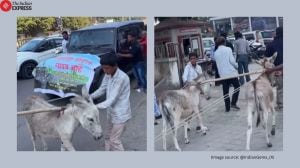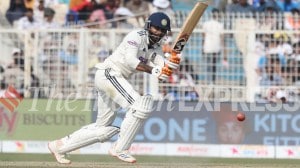After kisan-speak, PM, Rajnath must walk the talk
Those who wish to see India emerge as a developed nation in a holistic sense—prosperous, harmonious, egalitarian and culturally vibrant...

Those who wish to see India emerge as a developed nation in a holistic sense—prosperous, harmonious, egalitarian and culturally vibrant—know very well the critical importance of two large but long-neglected sections of our economy: SMEs (small and medium enterprises) and SMFs (small and marginal farmers). Of the two, the apathy that SMFs suffer is far greater.
SMEs have at least some mai baap. They have their associations which, though not a millionth as influential as a CII or a FICCI, can still wrangle an occasional 10-minute appointment with a minister or a secretary in Delhi. And, lately, even FICCI and CII have begun to pay greater attention to SMEs, aware of how much corporate India’s own profitability depends on their financial health, quality standards and technological upgradation.
 In comparison, SMFs have no voice at all in our system, despite constituting 78 per cent of the farming community. For most SMFs, farming has become a guaranteed source of indebtedness, not income. With indebtedness comes distress sale, destitution, dislocation and migration to cities. In extreme cases, the shame and pain of debt leads to suicide.
In comparison, SMFs have no voice at all in our system, despite constituting 78 per cent of the farming community. For most SMFs, farming has become a guaranteed source of indebtedness, not income. With indebtedness comes distress sale, destitution, dislocation and migration to cities. In extreme cases, the shame and pain of debt leads to suicide.Indeed, much of Indian agriculture is today in a deep systemic crisis, but the crisis is just not making it to the top of the national agenda. The political leadership’s attention to the crisis is largely episodic and often in the nature of scoring points over rivals. How many times has Parliament had in-depth discussions on agriculture and the rural economy? Top-level bureaucracy has little time and interest in poor farmers’ issues.
For the media, especially the English-language ‘national’ media, SMFs don’t even exist—almost. How can they, when they neither buy its products, nor consume the products that are advertised in them? If you aren’t a consumer, you don’t really count—that’s the philosophy of the advertisement-driven big media today. And since the media does very little rural reporting, our metropolitan elite has lost nearly all contact with the Indian kisan—physical, mental and cultural. When most of our media owners and editors have concluded that fashion designers deserve more print space and broadcast time than farmers, one can imagine how warped our development priorities have become.
The bitter truth is, we’ve become far too enamoured of the razzle-dazzle of the rapidly globalising urban India to worry about the agony of the poor in rural Bharat. Amartya Sen has drawn attention to this widening divide with a devastating imagery: ‘‘Our vision of the future of India cannot be one that is half-California and half sub-Saharan Africa.’’
In this disturbing context, last week brought two welcome high-level pronouncements. In his thought-provoking inaugural address at the 93rd Indian Science Congress in Hyderabad, whose theme this year was agriculture, Prime Minister Manmohan Singh was refreshingly candid. Agriculture’s share in our national income, he cautioned, is rapidly falling even though the population dependent on agriculture continues to remain very high. He acknowledged the two general criticisms leveled against ‘the first Green Revolution’: it did not benefit dry-land agriculture; and it mostly helped large farms and big farmers. He also highlighted the urgency of launching a Second Green revolution, an idea earlier mooted by Atal Behari Vajpayee, who also constituted the first ever National Kisan Commission to impart flesh and blood to the concept.
Singh did well to endorse the commission’s recommendations, contained in an excellent report prepared by the eminent agri-scientist Dr M S Swaminathan. One hopes that the PM will now walk the talk and get the capital’s kisan-unfriendly establishment to begin implementing the many Second Green Revolution initiatives—‘‘with a special focus’’, as he himself emphasised, ‘‘on dry-land agriculture and to benefit small and marginal farmers’’.
The second welcome kisan-speak came from Rajnath Singh, the BJP’s newly elected president. He encapsulated his priorities in three words: ‘Bharatmata, Janata and Annadata’. This may sound rhetorical to cynics, but as one who interacted closely with the former agriculture minister in the Vajpayee government I know that his concern for the ‘annadata’ is genuine. For example, he was convinced that the crop insurance scheme, although necessary, was not sufficient to benefit poor and dry-land farmers. He asked his officers to design a ‘guaranteed income insurance scheme’ for them. He also wanted a multi-pronged initiative to ensure that every SMF family in a village has at least one non-farm income-generating activity. He tried to launch an exclusive kisan TV channel in every Indian language.
Sadly, he did not have a sufficiently long tenure to push his innovative ideas. (The Vajpayee government had four agriculture ministers in six years—one reason why agriculture didn’t receive as much attention as IT, telecom and highways did.)
At a time when the BJP sorely needs to overcome its internal convulsions and focus on issues that concern the people, its new chief has done well to announce that farmers, especially SMFs, will be his priority. Of course, there is a big difference between intent and implementation. Therefore, like the PM, he too must now walk the talk.
A parting observation. Today we have one of the ablest ministers in Krishi Bhavan. What a pity that his time and energy, so badly needed to tackle the complex problems of Indian agriculture, have found a diversion in cricket. Sharad Pawar should have known that the cash-rich world of Indian cricket didn’t really need him, whereas India’s kangaal (destitute) kisans need all the governmental attention they can get.
Write to sudheenkulkarniexpressindia.com





- 01


























